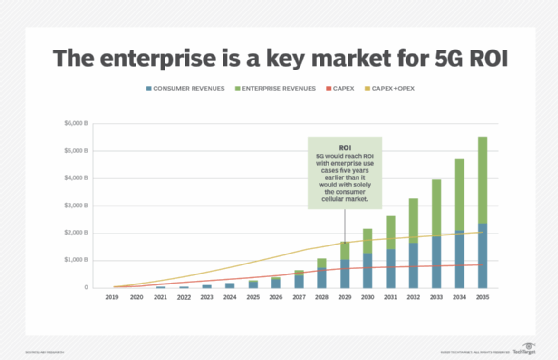
ake78 (3D & photo) - Fotolia
What experts say to expect from 5G in 2021
In this roundup of networking blogs, experts explore 5G's potential in 2021, including new business and technical territories 5G may explore and features to transform enterprises.
While 2020 seemed to be the year of 5G, 2021 is shaping up to take the title for its own.
Despite some production delays due to the COVID-19 pandemic, most carriers deployed at least some 5G connectivity in 2020, and 5G devices were also announced, bringing the next generation of cellular technology closer to a fully deployed reality. Yet, 5G in 2021 will continue to bring advanced features and force operators to consider moving into business sectors they haven't entered before. Three networking bloggers explored these innovations and painted a picture of 5G in the new year.
Overall, 5G in 2021 will likely see operators pairing 5G with other technology initiatives, as they discover how to best monetize 5G and the features that will boost indoor 5G use cases.
Is 5G the catalyst for open networking models?
The top technology initiatives for operators in 2021 are 5G deployment and open networking models, and the two may depend on each other, according to Tom Nolle, president of CIMI Corp. Additionally, most new or 5G-related technology initiatives will benefit from 5G's well-funded budgets and receive sufficient funding in turn.
5G and open networking will likely be a successful pair, Nolle wrote in a CIMI blog post, because operators are guaranteed to deploy 5G even though it is unlikely to provide much revenue for them in 2021. As a result, 5G and any technology associated with it could have a sufficient financial life span. If operators want to head in the direction of open networking, they can pair their 5G timeline with their open network plans to ensure those plans get funding in the future.
"When you're looking at operator technology initiatives, it's not the brilliance of the technology that matters, but how well the technology is funded," Nolle wrote. "Nobody questions 5G funding credibility for 2021, period. That makes 5G almost unique, and that makes things that are tied to 5G automatic concept winners."
However, the potential for open models also forces operators to consider 3rd Generation Partnership Project standards for radio access and core networks, so operators don't start to deploy an open 5G network and, for any reason, have to reverse it or not fully deploy the open model. If operators conform to official standards, they can gradually implement an open model on a per-element basis, Nolle wrote. This could provide more flexibility and potentially lead to more widespread use of open networking models.
Read more of Nolle's predictions for 5G and open networking, including their influences on user and control planes.
5G in 2021 will see the growth of enterprise use cases
Operators aren't sure how to gain revenue from 5G yet, which is why many of them are turning to 5G services and features that will benefit the enterprise market, including ultrareliable low latency and higher throughput. This also brings operators into different verticals than they traditionally explore, such as IoT and cybersecurity, according to Siow Meng Soh, senior technology analyst at GlobalData.
That isn't to say operators have never reached across business sectors to form relationships; in the past, these relationships existed but rarely had depth or moved "beyond a vanilla horizontal stack," Soh wrote. However, many enterprises rely on operators to inform them how technologies like 5G can benefit their businesses, so operators must understand those benefits, as well as new territories 5G could cross into and challenges that may pop up.

One way for operators to adjust to this new but necessary knowledge base is to gain expertise in a few specific business or technology areas to provide dedicated services and capabilities for those sectors. For businesses from sectors outside of their chosen realm of expertise, operators could provide traditional connectivity or services. Or operators could offer 5G as a foundational platform to enable more open systems or interoperability, Soh wrote.
"In 2021, telcos that have committed to 5G and have made significant progress in 5G deployment will look at best practices in other markets," Soh wrote. "They will need to build expertise, develop an ecosystem of partners, and work with customers on proofs of concept to demonstrate the business case for 5G solutions."
Explore more of Soh's analysis of 5G in enterprise markets.
What will indoor 5G look like in 2021?
As operators globally deploy 5G, Asian markets -- South Korea, in particular -- have showcased effective strategies for simultaneous outdoor and indoor connectivity deployment. The indoor environments include airports, train stations and shopping malls that use digital indoor systems for connectivity, as opposed to distributed antenna systems, wrote Dimitris Mavrakis, senior research director at ABI Research.
These digital indoor systems can lower deployment costs and enable 4G and 5G to operate together in a single system for future compatibility, which, in turn, could reveal what future, 5G-connected enterprises may look like. Specific use cases Mavrakis noted included a service from Huawei with a feature called distributed massive multiple input, multiple output (MIMO), which was developed for the specific demands of indoor enterprise spaces.
Distributed massive MIMO takes a page out of multiuser MIMO's book, as it supports uplink and downlink capabilities, like MU-MIMO, and reduces the likelihood of signal interference. The example of Huawei's service aims to show how distributed massive MIMO can improve capacity and UX, Mavrakis wrote. These advances also reveal the potential to develop services and tools that suit both consumer and enterprise needs, which will be critical for large-scale 5G deployments.
"The distributed massive MIMO breakthrough is truly the next step in enhancing in-building wireless deployments and is the first appearance of massive MIMO indoors," Mavrakis wrote. "No more careful indoor planning is necessary to minimize interference from adjacent cells, while the level of service, in terms of both capacity and latency, will propel indoor wireless systems to a new era."
Learn more about Mavrakis' insights on indoor 5G connectivity.






